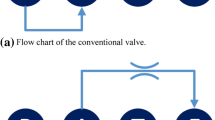Abstract
Internal vibration of the valve spring is a critical factor in determining the dynamic characteristics of high-speed valve train systems. Because precise prediction of the spring surge amplitude is a difficult problem, especially for nonlinear variable-pitch springs, the development stage requires a process of trial and error. In the present study, a new method that considers the variable natural frequency and variable damping ratio is proposed to predict the spring surge amplitude. First, the change in the natural frequency and damping ratio caused by compression is predicted from the initially given pitch curve at the free height. Second, the spring surge amplitude is estimated by solving the wave equation with nonlinear variable coefficients. The surge amplitudes of typical valve springs are also measured using a motoring test rig and are compared with theoretical results predicted by the spring drawing and cam profile data.
Similar content being viewed by others
Abbreviations
- d :
-
spring wire diameter [mm]
- R :
-
spring mean coil radius [mm]
- c :
-
speed of wave propagation [m/s]
- k :
-
spring stiffness [N/mm]
- m :
-
mass of active coils [kg]
- t :
-
time [s]
- x :
-
distance along spring axis [mm]
- L :
-
spring length [mm]
- ϕ :
-
camshaft rotation angle [deg]
- n :
-
order of spring natural frequency
- G n (ϕ):
-
dynamic component of spring internal vibration, function of camshaft angle [mm]
- ω n (ϕ):
-
natural frequency, function of camshaft angle [Hz]
- ζ(ϕ):
-
damping ratio, function of camshaft angle
- N α :
-
number of active coils
- E :
-
Young’s modulus of spring material [Pa]
- G :
-
shear modulus of spring material [Pa]
- ρ :
-
density of spring material [kg/m 3]
- υ :
-
Poisson’s ratio
- γ :
-
shear coefficient of wire cross section
References
Blair, B. G., McCartan, C. and Cahoon, W. (2010). Measurement and computation of the characteristics of progressive valve springs. SAE Paper No. 2010-01-1056.
Huber, R., Clauberg, J. and Ulbrich, H. (2010). An efficient spring model based on a curved beam with non-smooth contact mechanics for valve train simulations. SAE Paper No. 2010-01-1057.
Kim, D. and David, J. W. (1990). A combined model for high speed valve train dynamics (partly linear and partly nonlinear). SAE Paper No. 901726.
Liu, H. and Kim, D. (2009). Effects of end coils on the natural frequency of automotive engine valve springs. Int. J. Automotive Technology 10,4, 413–420.
Lee, J. and Patterson, D. J. (1997). Nonlinear valve train dynamics simulation with a distributed parameter model of valve springs. J. Engineering for Gas Turbines and Power, 119, 692–698.
Ortmann, C. and Skovbjerg, H. (2000). Powertrain analysis applications using Adams/Engine powered by FEV Part I: Valve Spring. Int. ADAMS Users Conf., Rome.
Pisano, A. P. and Freudenstein, F. (1983). An experimental and analytical investigation of the dynamic response of a high-speed cam-follower system. Part 2: A combined, lumped/distributed parameter dynamic model. J. Mechanisms, Transmissions, and Automation in Design, 105, 699–704.
Phlips, P. J., Schamel, A. R. and Meyer, J. (1989). An efficient model for valvetrain and spring dynamics. SAE Paper No. 890619.
Schamel, A. R., Hammacher, J. and Utsch, D. (1993). Modeling and measurement techniques for valve spring dynamics in high revving internal combustion engines. SAE Paper No. 930615.
Seidlitz, S. (1989). Valve train dynamics — A computer study. SAE Paper No. 890620.
Tolstov, G. P. (1962). Fourier Series. Dover Publications, Inc. New York.
Author information
Authors and Affiliations
Corresponding author
Rights and permissions
About this article
Cite this article
Liu, H., Kim, D. Estimation of valve spring surge amplitude using the variable natural frequency and the damping ratio. Int.J Automot. Technol. 12, 631–638 (2011). https://doi.org/10.1007/s12239-011-0073-1
Received:
Revised:
Published:
Issue Date:
DOI: https://doi.org/10.1007/s12239-011-0073-1




